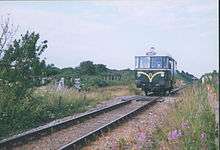Waggon- und Maschinenbau GmbH Donauwörth railbus
| Waggon und Maschinenbau, G.m.b.H., of Donauworth railbus | |
|---|---|
|
Waggon und Maschinenbau railbus at Weybourne shed, North Norfolk Railway | |
| In service | 1958 - 1967[1] |
| Manufacturer | (Waggon- und Maschinenbau GmbH Donauwörth) |
| Number built | 5[2] |
| Formation | railbus |
| Capacity | 56 |
| Operator(s) | British Railways |
| Line(s) served |
Witham–Maldon branch line, Braintree Branch Line, Saffron Walden Railway[2] |
| Specifications | |
| Car length | 41 ft 10 in (12.75 m) (over body), 45 ft 9 3⁄4 in (13.964 m) (over buffers)[2] |
| Width | 41 ft 8 1⁄2 in (12.713 m) (over panels)[2] |
| Height | 11 ft 9 in (3.58 m)[2] |
| Maximum speed | 55 mph (89 km/h)[2] |
| Weight | 15 tons |
| Traction system | 6-speed electro mechanical gearbox[2] |
| Prime mover(s) | Buessing 6-cylinder horizontal[2] |
| Power output | 150 hp (110 kW) at 1,900 r.p.m.[2] |
| Track gauge | 1,435 mm (4 ft 8 1⁄2 in) standard gauge |
The British Railways Waggon und Maschinenbau railbuses were delivered in April 1958. They were based at Cambridge until 1964. They were withdrawn in 1966 and 1967.[1]
Background
The WMD railbuses were five of the total of 22 delivered in 1958 from five manufacturers (the rest British). They were planned to have "extensive trials". The underframe, power equipment, transmission and brake gear were similar to the Uerdingen railbus, common on the German Federal Railway. They were shipped via the Harwich-Zeebrugge train ferry.[2] It was hoped they might be the answer to increasing losses on rural branch-lines. In the first year of the railbuses they saved £66,000 in operating costs, but the branches were still losing £4,000 a year (£85,000 at 2014 prices[3] - 2014 subsidies amounted to almost £2.3bn!).[4] However, at the time, such losses were unacceptable, and the lines they worked were closed.[1]
Construction
The underframes were built of channel shaped cross-beams welded to flanged plate longitudinal girders. The corrugated steel floor was welded on top.[2]
The body was formed of alloy panels rivetted on a light steel frame. Roof plates were crimped to increase rigidity. The body was suspended from four points on the frame, connected by hydraulic shock absorbers.[2]
Unlike most BR diesel units, the accelerator was foot controlled. Also unusual at that time, were the power operated central doors and air powered disc brakes.[2]
Operation
Initially the buses worked the Maldon, Braintree, and Saffron Walden lines. They had too few seats for the Braintree branch and were used on the Mildenhall line from July 1958. Mildenhall closed in 1962. E79961/3/4 had their Buessing engines replaced by AEC A220X engines, also of 150 hp, in 1962-3, due to the cost of importing replacements from Germany. Their other branches closed in 1964, after which they spent most of their time in store at Cambridge. In 1965 79963 and 79964 were trialled on the Alston Line, but couldn't haul parcels vans and had heating problems in winter. 79961 and 79964 were transferred to serve Millers Dale in 1966, but that branch closed in 1967 and M79961 was the last to be withdrawn in August 1967.[2]
Preservation

Four of the five buses have been preserved. They have been transferred a number of times between preserved railways.
| Vehicle no. | Location | Comments |
|---|---|---|
| 79960 | Ribble Steam Railway | Operational.[5] |
| 79962 | Keighley and Worth Valley Railway | Operational.[6] |
| 79963 | East Anglia Railway Museum | under extensive overhaul.[7] |
| 79964 | Keighley and Worth Valley Railway | Operational.[8] |
References
- 1 2 3 Railway Magazine January 1968 pp. 4-9 J M Tolson: Too little, too light and too late - A survey of British Railways diesel railbuses
- 1 2 3 4 5 6 7 8 9 10 11 12 13 14 Railway Magazine July 1958 pp. 499-501 German Railbuses for British Railways
- ↑ Bank of England inflation calculator
- ↑ Subsidy per passenger mile by Train Operating Company: DfT franchised train operators: 2013/14
- ↑ http://www.cs.vintagecarriagestrust.org/se/CarriageInfo.asp?Ref=2068
- ↑ http://www.cs.vintagecarriagestrust.org/se/CarriageInfo.asp?Ref=2069
- ↑ http://www.cs.vintagecarriagestrust.org/se/CarriageInfo.asp?Ref=2070
- ↑ http://www.cs.vintagecarriagestrust.org/se/CarriageInfo.asp?Ref=2071
External links
- youtube Llangollen Railway video - gives a good idea how much they bounced!
- E79960 now at Ribble Steam Railway
- E79962 being restored at the Museum of Rail Travel
- history and photos of E79963, now at East Anglian Railway Museum
- history and photo of M79964, now at Keighley and Worth Valley Railway
- Railcar website with photo
